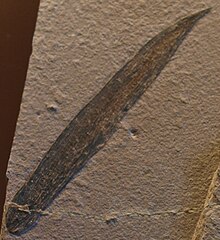Halichondrites
| Halichondrites Temporal range: [1]
| |
|---|---|

| |
| Fossil detail of a Halichondrites elissa, on display at the Naturhistorisches Museum, Vienna. | |
| Scientific classification | |
| Domain: | Eukaryota |
| Kingdom: | Animalia |
| Phylum: | Porifera |
| Class: | Demospongiae |
| Order: | †Protomonaxonida |
| Family: | †Halichondritidae |
| Genus: | †Halichondrites Dawson, 1889 |
| Species | |
Halichondrites, sometimes mis-spelt Halicondrites[4] is an extinct genus of sea sponge known from the Middle Cambrian Burgess Shale. Template:Gpb abundance
Taxonomy and species
The genus Halichondrites was erected by John William Dawson in 1889, who described the species Halichondrites confusus from the Ordovician of Quebec at Little Métis.
In 1920, Charles Doolittle Walcott, considering H. confusus to be inadequately described, himself described Halichondrites elissa from the Middle Cambrian Burgess Shale, placing it as the type species of the genus.[2]
In 1936, Howell & Landes described and provisionally placed in the genus two further species from the Lower Ordovician of Wisconsin, Halichondrites? actiniformis and Halichondrites? robustus.[3]
Another species, "Halichondrites graphitiferus", was described by George Frederick Matthew in 1890 from the Precambrian of Saint John, New Brunswick. However, the organic nature of this species has been questioned; according to Miller (1987), who examined the holotype, the "spicules" described by Matthew are more likely a combination of scratches and cleavage on graphite.[5]
External links
References
- ^ Botting, J. (2007). "'Cambrian' demosponges in the Ordovician of Morocco: Insights into the early evolutionary history of sponges". Geobios. 40 (6): 737–748. doi:10.1016/j.geobios.2007.02.006.
- ^ a b Walcott, C. D. (1920). "Cambrian geology and paleontology IV:6—Middle Cambrian Spongiae". Smithsonian Miscellaneous Collections. 67: 261–364.
- ^ a b c Howell, B. F.; Landes, R. W. (1936). "New Monactinellid Sponges from the Ordovician of Wisconsin". Journal of Paleontology. 10 (1): 53–59. JSTOR 1298365.
- ^ "Archived copy". Archived from the original on 2011-07-19. Retrieved 2010-04-29.
{{cite web}}: CS1 maint: archived copy as title (link) - ^ Miller, R. F. (1987). "On the inorganic character of Halichondrites graphitiferus Matthew, a supposed sponge from the Precambrian of Saint John, New Brunswick". Canadian Journal of Earth Sciences. 24 (9): 1913–1915. doi:10.1139/e87-180.
